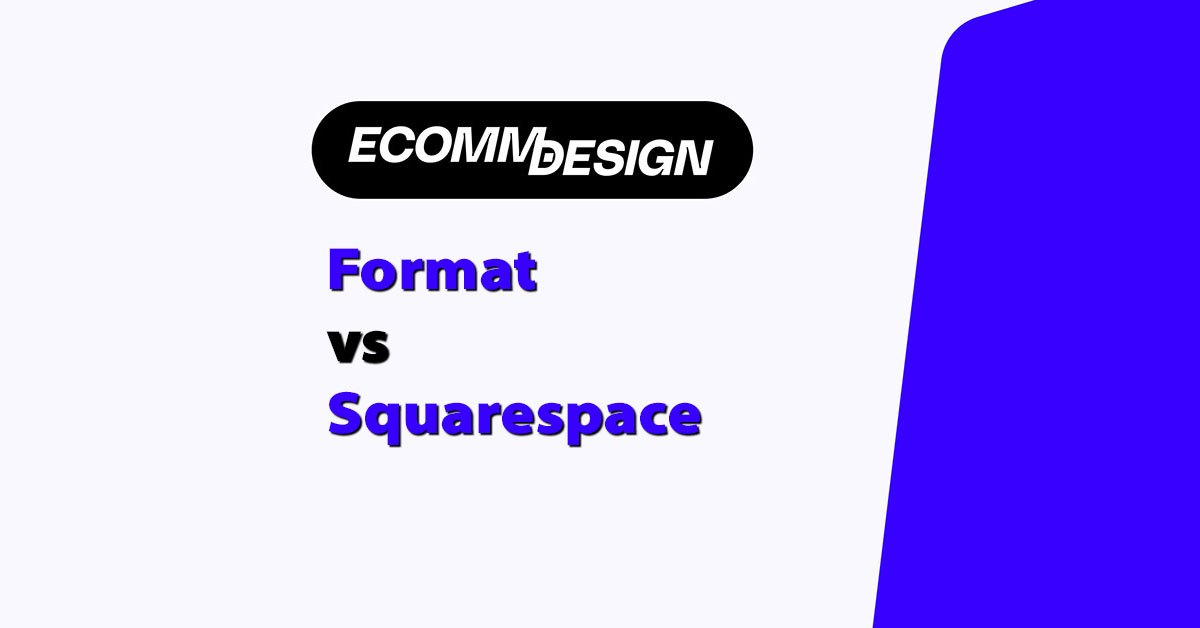
Quick answer:
If your primary goal is to present a visually striking portfolio with occasional sales—particularly as a photographer, artist, or designer—Format offers a streamlined, aesthetically focused experience tailored to that need.
On the other hand, if you’re building a content-rich site with ecommerce at its core, and you require more flexibility, scalability, and control over the user journey and site architecture, Squarespace is the more comprehensive and strategic choice.
What Is Format? What Is Squarespace?
Format is a website builder made for photographers, visual artists, and designers who need a sleek portfolio fast. It’s lean, visual, and doesn’t overload you with unnecessary tools.
Squarespace is an all-in-one platform for building websites, blogs, and online stores. It’s more robust. It offers deeper ecommerce, blogging, and SEO features.
| Feature | Format | Squarespace |
|---|---|---|
| Audience | Creatives (photographers, artists) | General (ecommerce, blogs, creatives) |
| Focus | Portfolios, client proofing | Ecommerce, content, design |
| Strength | Simplicity, portfolio design | SEO, content tools, flexibility |
| Weakness | Limited SEO, limited scaling | Steeper learning curve |
Use Format if you’re a solo creative who wants to get a portfolio up fast with ecommerce baked in.
Go with Squarespace if you care about blogging, ranking in Google, and selling at scale.
Who Is Each Platform Best For?
Over the years, I’ve matched hundreds of clients to platforms based on business model, growth goals, and creative direction.
While both Format and Squarespace can serve a wide range of users, they are fundamentally designed for very different kinds of creators.
Knowing who each one serves best can save you hours of frustration — and a lot of redesign work later.
Let’s break it down:
| User Type | Best Platform |
|---|---|
| Photographer | Format |
| Visual Artist | Format |
| Designer | Format |
| Blogger | Squarespace |
| Digital Product Seller | Squarespace |
| Small Ecommerce Brand | Squarespace |
| Service-Based Creative | Depends |
| Large Catalog Retailer | Neither (look at Shopify) |
Format is best for:
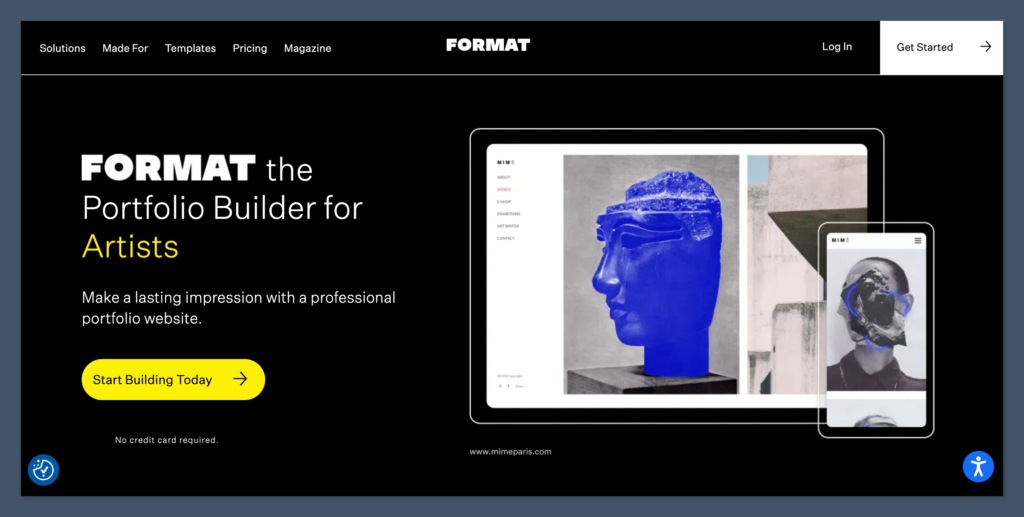
- Visual-first professionals who don’t want to get lost in menus or code
- Photographers looking for seamless client proofing and image galleries
- Artists who want a digital space to showcase their portfolio with minimal setup
- Designers who need a fast, clean way to display work without managing a full CMS
Format leans heavily into simplicity.
If you’re not interested in writing blogs, building funnels, or tracking SEO performance, it’s a low-maintenance solution that respects your time and aesthetic.
Squarespace is best for:
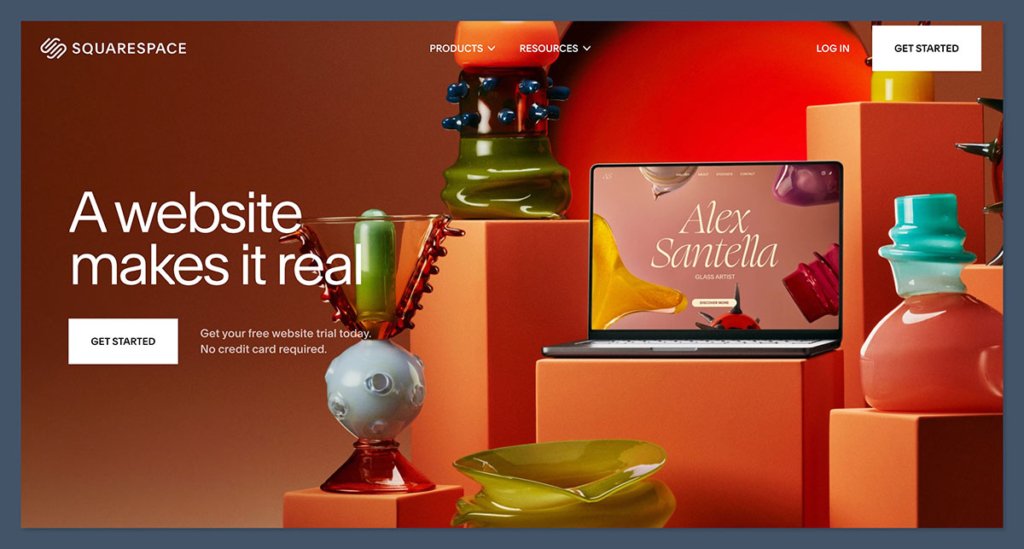
- Ecommerce entrepreneurs who want to scale a small online store
- Content creators and marketers who care about blogging and organic growth
- Creatives who sell digital downloads, offer booking services, or host courses
- Artists and designers with hybrid needs: both showing and selling
It also excels for creators who want to grow their brand beyond just a portfolio — if your long-term plan includes publishing, ranking on Google, or building an email list, Squarespace has the infrastructure to support that.
Use Case Comparison
| Use Case | Format | Squarespace |
|---|---|---|
| Showcase a minimalist portfolio | ✅ Ideal | Possible but heavier |
| Sell prints or photo packages | ✅ Simple integration | ✅ Better upsell tools |
| Blog weekly and grow traffic | ❌ Limited | ✅ Designed for it |
| Sell multiple digital products | ⚠️ Basic functionality | ✅ Full control |
| Manage a growing product catalog | ❌ Not scalable | ✅ With limitations |
| Offer client proofing and private albums | ✅ Built-in | ❌ Not native |
Final Thoughts:
Format is a great fit for creators who want to “set it and forget it” — portfolio-first websites with light ecommerce.
Squarespace works better for creatives who think long-term and treat their website as a business engine, not just a gallery.
It’s not about which one is better overall — it’s about which one aligns with your workflow, your business model, and your creative priorities.
Pros and Cons
Format Pros:
- Super clean templates made for visual work
- Simple backend that doesn’t confuse creatives
- Built-in client proofing and galleries
- Affordable starter pricing
- Optimised for showcasing high-res photography
- Easy image uploading and sorting with drag-and-drop
- Privacy and access control for portfolios and galleries
Format Cons:
- Weak blogging tools
- SEO options are basic
- Not scalable for larger ecommerce catalogs
Squarespace Pros:
- Excellent blogging & content structure for SEO
- Deep product catalog options
- Great template flexibility and design tools
- Integrations with shipping, scheduling, and email
- Strong analytics and ecommerce insights built-in
- Integrates well with scheduling, email, and memberships
- Clean mobile responsiveness across templates
- Supports custom code and advanced design tweaks
Squarespace Cons:
- Can be slow if you overbuild
- Slight learning curve for new users
- Higher pricing tiers needed for full features
Templates and Design Tools for Creatives
As someone who’s spent over a decade building sites for photographers, artists, and ecommerce brands, I can tell you — the quality of templates and the flexibility of the design tools matter more than most people realise.
It’s not just about aesthetics. It’s about usability, load speed, branding control, and how well a layout adapts to different content types.
Both Format and Squarespace offer high-quality templates, but the philosophy behind each platform’s design system is fundamentally different.
Format Templates and Tools
Format is intentionally minimal.
Its template library is small, but it’s curated with precision — each layout is designed to put your work front and centre, free of distractions.
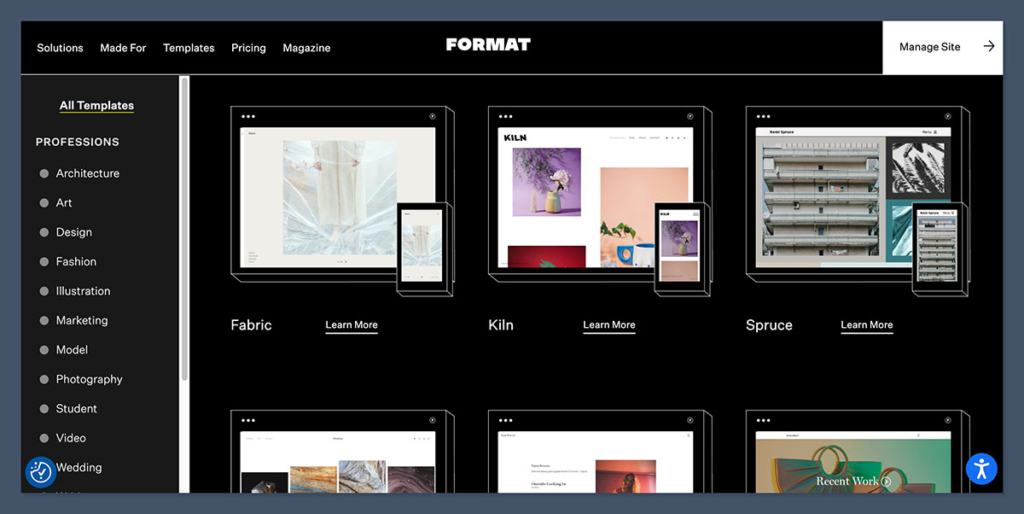
Key strengths:
- Purpose-built templates for visual artists and photographers
- Image-first design with zero visual clutter
- Preconfigured gallery styles for horizontal, vertical, tiled, and fullscreen layouts
- Built-in client proofing pages that align with the overall theme
- Custom page types (e.g. “Store”, “Proofing”, “About”, “Gallery”) that streamline setup
Limitations:
- Limited flexibility in customising layout structure
- Fewer options for non-visual content (e.g. text-heavy pages, forms, or interactive sections)
- Cannot create completely custom layouts without developer input
If you want something that looks professional right out of the box, and you have no desire to tinker with layout grids or code blocks, Format is incredibly efficient.
Squarespace Templates and Tools
Squarespace is more expansive. Its templates cater to a wider range of use cases — from ecommerce storefronts and personal brands to full-scale media blogs.
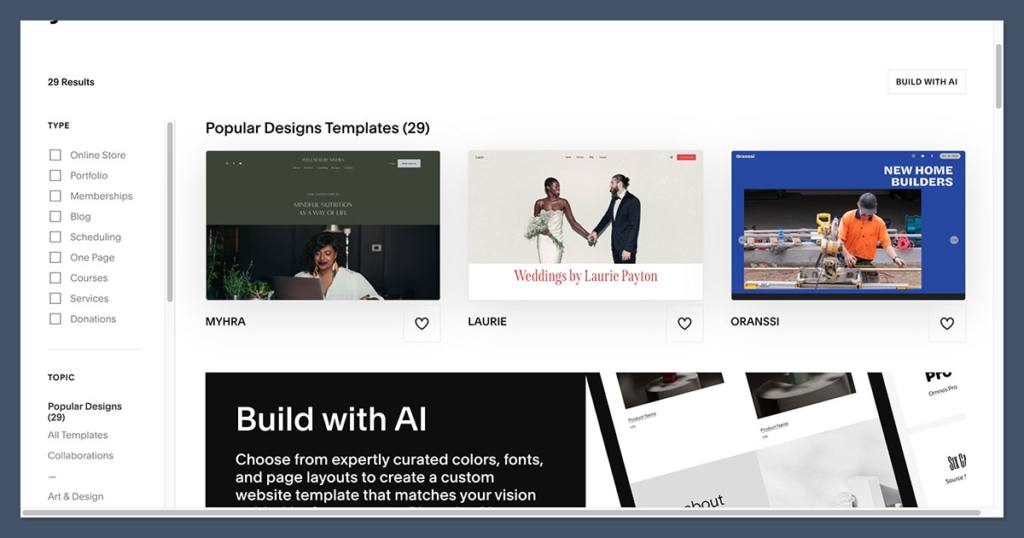
Key strengths:
- Dozens of professionally designed templates across categories: portfolio, store, blog, service, etc.
- Built on Fluid Engine (block-based editor), offering drag-and-drop flexibility
- Customisable headers, footers, and section backgrounds without touching code
- Integration of rich media: video, animations, forms, calendars, and galleries
- Ability to duplicate, tweak, or completely redesign pages within a template
Limitations:
- More complex interface — can overwhelm users new to site building
- Design inconsistencies may occur if too many custom blocks are layered without structure
Squarespace doesn’t limit you to a fixed style. If you want full control over typography, spacing, and hierarchy, or if you’re looking to evolve your site over time with new campaigns and content strategies, it gives you the tools to do so.
Template Comparison Table
| Feature | Format | Squarespace |
|---|---|---|
| Template focus | Portfolios | Broad: blogs, stores, portfolios |
| Number of available templates | ~70 curated designs | 110+ templates across categories |
| Custom layout control | Limited | Extensive via Fluid Engine |
| Designed for visual storytelling | Yes | Yes, but broader in purpose |
| Built-in ecommerce templates | Basic storefronts | Full-featured ecommerce layouts |
| Ideal for text-heavy sites | No | Yes |
Final Thoughts:
Format provides a controlled, curated environment that lets visual content shine with minimal effort. It’s ideal for creators who want structure without distraction.
Squarespace, on the other hand, offers far more freedom — both a gift and a challenge. It’s better suited for users who want their site to grow in complexity over time, and who need more diverse page types beyond galleries.
Tools for Creatives: Format vs Squarespace
Beyond templates, the actual tools that help artists run their creative business online are what separate a good platform from a frustrating one.
Over the years, I’ve seen how the right features — even small ones — can save hours of admin work and create a smoother client experience.
Artists today don’t just need a digital gallery — they need tools for selling, showcasing, sharing private work, and even proofing work with clients.
Both Format and Squarespace address these needs in very different ways.
Format: Built Specifically for Artists and Creatives
Format was created with the working artist in mind. It’s a portfolio platform first — and it shows. Almost every feature is geared toward photographers, designers, illustrators, and other visual professionals.
Notable tools for artists:
- Client proofing system: Create private galleries with password protection where clients can review and approve images
- High-res image support: Auto-optimized image compression while maintaining quality
- Lightbox and fullscreen viewer modes: Built into most templates for immersive viewing
- Gallery-specific layouts: Custom page types for showcasing series, projects, or archives
- Store for limited edition sales: Sell prints or digital downloads with minimal ecommerce setup
- Privacy controls: Password-protected pages, hidden galleries, and client-only access
- Auto-resizing: Images scale automatically for desktop, tablet, and mobile
Format makes it incredibly easy for an artist to manage both their public portfolio and their behind-the-scenes client workflows — all without needing third-party tools.
Squarespace: Versatile Tools with Artistic Flexibility
Squarespace isn’t exclusively built for artists, but its powerful design system can be tailored to creative workflows. It shines when you want to combine art presentation with other content types — blogs, sales funnels, booking systems, or lead generation.
Notable tools for artists:
- Portfolio blocks: Drag-and-drop sections to create interactive galleries, sliders, and project previews
- Image editor & filters: Adjust brightness, contrast, crop, and add filters directly in the dashboard
- Custom content layouts: Combine image, video, text, and call-to-actions in any configuration
- Product pages with artistic detail: Add variations (size, edition, framing) for selling prints
- Email campaigns: Integrated newsletters for promoting new collections or exhibitions
- Scheduling tools: Offer online consultations, studio visits, or art classes via Acuity integration
- Memberships & private content: Sell exclusive access to courses, videos, or premium galleries
For artists building a broader digital presence — especially if content and ecommerce are part of the strategy — Squarespace opens more doors.
Tool Comparison Table
| Feature/Tool | Format | Squarespace |
|---|---|---|
| Client proofing galleries | Yes (native) | No (requires workaround) |
| Built-in lightbox viewer | Yes | Yes |
| Image editor | Basic cropping | Advanced (filters, adjustments) |
| Drag-and-drop page builder | No (template-locked) | Yes (Fluid Engine) |
| Digital product sales | Yes (simple store) | Yes (with variations + automation) |
| Custom gallery layouts | Pre-set per template | Customisable with blocks |
| Built-in scheduling | No | Yes (via Acuity integration) |
| Email marketing | No | Yes (built-in tool) |
| Private member-only content | Limited password protection | Full membership capabilities |
Final Thoughts:
Format excels at giving artists what they need, without the clutter: proofing, privacy, and beautiful image presentation. It’s focused, intuitive, and fast.
Squarespace is a broader platform with artistic flexibility. If you’re blending your portfolio with ecommerce, education, or audience-building, its wider feature set becomes incredibly valuable.
If you’re a purist — someone who just wants to showcase and sell work — Format saves time.
If you’re building a digital ecosystem around your art — blog, store, email list — Squarespace scales with you.
Would you like me to expand on tools for specific artist types (e.g. illustrators, painters, mixed media)?
Ecommerce Features
If you’re selling anything online — whether that’s prints, merchandise, digital downloads, or commissioned services — ecommerce tools make or break your workflow.
They’re not just about taking payments. The right platform needs to support inventory, customer communication, shipping, analytics, and sometimes even fulfilment.
This is where the differences between Format and Squarespace become clear.
Format offers the essentials in a lightweight setup designed for simplicity. Squarespace, by contrast, gives you a full-featured ecommerce engine that can scale as your business grows.
Format: Basic, Streamlined Ecommerce
Format is designed for visual artists who sell a curated set of works — usually in low volume. The ecommerce features feel like an extension of your portfolio rather than a full-blown storefront.
Format ecommerce strengths:
- Sell physical and digital products: Perfect for prints, photo packages, e-books, or design files
- Stripe integration: Fast, secure payments (but no PayPal or Apple Pay)
- Custom product pages: Add descriptions, images, pricing, and file downloads
- Private store options: Useful for client galleries, exclusive editions, or limited sales
- Order tracking dashboard: Simple interface for monitoring sales
Format ecommerce limitations:
- No product variants (e.g. size, colour)
- No inventory automation or stock control
- No upsells, bundling, or custom checkout flows
- No built-in abandoned cart emails or CRM features
In short, Format works for the artist who sells 5–10 pieces a month — not the store with a constantly rotating catalog or a detailed sales funnel.
Squarespace: Full-Featured Ecommerce for Creators
Squarespace’s ecommerce functionality goes much deeper. It’s designed not only for selling, but for building a complete buyer experience — from browsing to checkout to post-sale engagement.
Squarespace ecommerce strengths:
- Support for product variants: Perfect for offering different sizes, formats, or editions
- Multiple payment gateways: Stripe, PayPal, Apple Pay
- Subscriptions and memberships: Sell recurring access to courses, content, or art drops
- Digital and physical product support: Upload files or handle shipping with automated rules
- Abandoned cart recovery: Automated email follow-up for unfinished purchases
- Advanced product pages: Embed videos, specs, galleries, and cross-sells
- Integrates with third-party tools: ShipStation, Printful, Mailchimp, and more
- Sales analytics and customer insights: See trends, bestsellers, and conversion rates
Squarespace is ideal for creative entrepreneurs selling at scale — whether that’s limited-run prints or an entire product line.
Ecommerce Features Comparison Table
| Feature | Format | Squarespace |
|---|---|---|
| Payment options | Stripe only | Stripe, PayPal, Apple Pay |
| Digital downloads | Yes | Yes |
| Physical product support | Yes | Yes |
| Product variants (e.g. size, color) | No | Yes |
| Subscription products | No | Yes |
| Inventory management | Manual | Automatic stock tracking |
| Abandoned cart emails | No | Yes |
| Analytics and reporting | Basic sales dashboard | Full ecommerce analytics |
| Shipping integration | Manual setup | Automated zones + rates |
| CRM tools or email follow-up | No | Built-in email campaigns |
| Product reviews | Not supported | Not native, but workaround exists |
Final Thoughts:
Format gives artists a frictionless way to sell a few pieces without managing an online store in the traditional sense. It’s efficient, but intentionally minimal.
Squarespace offers everything a small ecommerce business might need — including tools to boost revenue, track performance, and engage customers after purchase. If you plan to grow beyond selling a few prints per month, it’s the smarter long-term investment.
Blogging Features
Blogging isn’t just about writing — it’s about building trust, authority, and organic traffic over time.
Whether you’re a creative sharing behind-the-scenes content, or an ecommerce seller using blog posts to drive product discovery, your platform’s blogging tools will determine how far your content can go.
This is where Format and Squarespace sharply diverge. Format doesn’t position itself as a content platform, and that shows in its limitations.
Squarespace, on the other hand, has built-in infrastructure that supports long-form publishing, SEO optimization, and content marketing.
Format: Minimal Blogging with Major Limitations
Format treats blogging as a secondary feature — and in practice, it feels like an afterthought. For some creators, this isn’t a problem.
If your site is purely visual, and you don’t plan on using content to drive traffic or leads, you may not even notice.
Format blogging tools:
- Basic blog module (optional add-on depending on plan)
- Text-only posts with optional images
- No categories, tags, or rich formatting
- No blog-specific SEO fields (e.g. title tags, meta descriptions, canonical URLs)
- No post scheduling, RSS feeds, or internal linking options
- No featured image functionality or excerpts
Real-world impact:
- Difficult to organise content if you publish more than a few posts
- Limited discoverability in search engines due to poor structure
- Not suitable for content marketing, tutorials, or long-form posts
Format blogging works if you want to write an occasional update or behind-the-scenes post — but it won’t scale into a real traffic channel.
Squarespace: A True CMS for Creators and Businesses
Squarespace comes with a fully functional blogging engine — similar to a simplified version of WordPress.
It’s built for creators who take content seriously and want their writing to support brand growth, email capture, and SEO.
Squarespace blogging tools:
- Drag-and-drop post builder: Add text, images, galleries, videos, and custom blocks
- Tags and categories for content organization and topic clusters
- Customisable URLs, meta titles, and descriptions for every post
- Built-in RSS feed, featured images, and scheduling options
- Markdown support, code blocks, and embedded social content
- Built-in commenting system or Disqus integration
- Automatically styled archive pages and author profiles
Real-world impact:
- Great for publishing tutorials, announcements, guides, or visual storytelling
- Easier to rank in search engines thanks to clean structure and metadata
- Makes content a scalable marketing tool — not just a vanity blog
If you’re planning to grow your site’s authority over time through content, Squarespace gives you the framework to do it properly.
Blogging Feature Comparison Table
| Feature | Format | Squarespace |
|---|---|---|
| Blog post editor | Basic WYSIWYG | Full content builder |
| Image/video embedding | Yes | Yes |
| Tags and categories | No | Yes |
| SEO fields per post | No | Yes |
| Featured images | No | Yes |
| Post scheduling | No | Yes |
| RSS feeds | No | Yes |
| Internal linking support | Manual | Native with rich linking tools |
| Markdown/code blocks | No | Yes |
| Commenting system | No | Yes (built-in or Disqus) |
Final Thoughts:
Format offers just enough blogging functionality for creators who write occasionally — but lacks the technical and structural features needed for serious publishing or content strategy.
Squarespace, by contrast, is built for content creators. Whether you’re writing thought pieces, SEO articles, or weekly updates, it gives you a clean editor, well-structured output, and full control over how your content is organised and displayed.
If your blog is a critical part of your business — whether it’s for SEO, storytelling, or sales — Squarespace is the far superior choice.
SEO and Rankings
In over a decade of working with ecommerce and creative websites, I’ve seen how a site’s underlying SEO structure can make or break its growth.
Good design means nothing if the platform doesn’t give you control over how your content is found and indexed by search engines.
When it comes to SEO capabilities, Format and Squarespace take two very different approaches. One is minimalist and locked-down. The other is far more configurable — designed with content, structure, and long-term search performance in mind.
Format: Basic SEO That Covers Only the Essentials
Format’s SEO capabilities are limited to the bare minimum. While its sites are clean and lightweight — which helps with load speed and indexing — the actual SEO tools are shallow.
Format SEO features:
- Basic meta title and description editing (on select plans)
- Automatic image optimization (compressed on upload)
- Responsive design and mobile-ready templates
- Secure HTTPS with SSL included
- Auto-generated sitemaps (but no control over indexing)
Major limitations:
- No control over URL slugs for blog posts or pages
- No support for schema markup (structured data)
- No integration with Google Search Console or Analytics by default
- No canonical tags, open graph settings, or alt text customization
- No blog taxonomy (no tags, categories, or archive pages)
What this means:
Format sites may look great and load quickly, but they don’t provide the structure that search engines rely on to categorise, crawl, and rank your content effectively.
For portfolio-only sites, this may not be a dealbreaker. But for anyone looking to build organic traffic — Format is not a serious SEO platform.
Squarespace: Full-Stack SEO for Content and Ecommerce
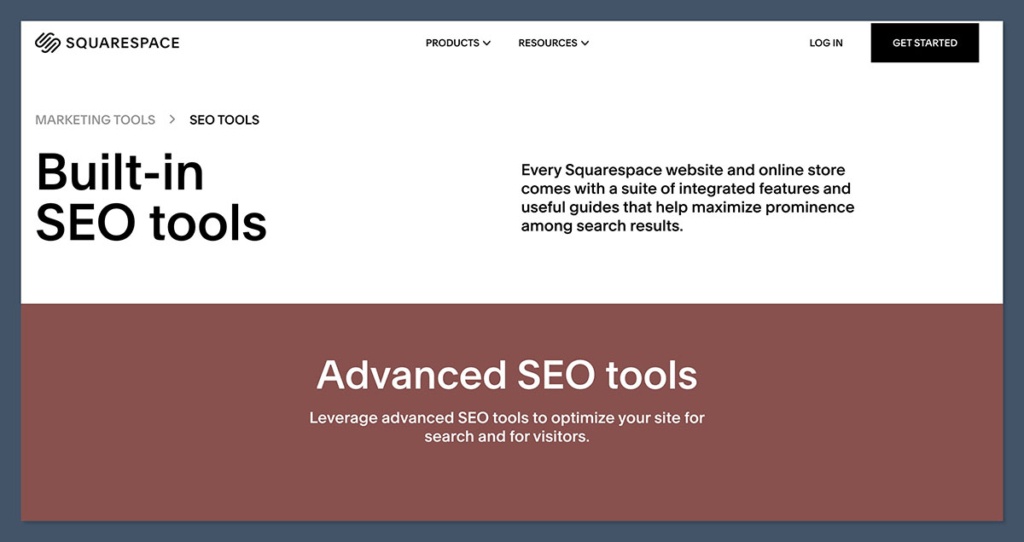
Squarespace offers a far more robust set of SEO tools — not just for pages and products, but also for blogs and structured content. It’s not as advanced as WordPress + plugins, but it gives you everything you need to compete in search, especially in local and niche ecommerce markets.
Squarespace SEO features:
- Full meta title + description editing on every page, post, and product
- Editable URLs with clean slugs (e.g.
/blog/how-to-frame-art) - Auto-generated and dynamic XML sitemaps
- SSL included on all plans
- Schema markup for products, articles, and events (automatic on most templates)
- Image alt-text editing, filename control, and responsive design
- Integrated tools for Google Analytics and Search Console
- Built-in redirects and canonical tags for duplicate content issues
- Open Graph and Twitter card controls for social sharing
Real-world SEO performance:
- Squarespace sites rank well when the content is structured properly and supported with backlinks
- Clients using Squarespace have achieved top 3 results for niche terms using consistent blogging and internal linking
- The platform supports SEO foundations without requiring plugins or developer help
If you’re planning to drive inbound traffic with product-led content, visual storytelling, or guides, Squarespace provides the on-page SEO framework to make that possible.
SEO Feature Comparison Table
| SEO Feature | Format | Squarespace |
|---|---|---|
| Meta titles + descriptions | Basic (limited fields) | Full control per page/post |
| Custom URLs / clean slugs | No | Yes |
| Schema markup | No | Yes (auto on most templates) |
| XML sitemap | Auto-generated (basic) | Auto-generated + dynamic |
| Image alt text | No custom alt text | Yes |
| Redirect management | Not available | Yes |
| Canonical tags | No | Yes (auto or manual) |
| Open Graph/social sharing tags | No | Yes |
| Google Analytics/Search Console | Manual workaround | Native integration |
| Page speed / mobile performance | Fast but image-heavy | Fast with CDN + image scaling |
Final Thoughts:
Format gives you a lightweight, mobile-ready site that will technically get indexed — but not optimised. Without clean URLs, alt text, or structured data, your SEO potential is capped early. It’s fine for portfolios that rely on referrals, not search.
Squarespace, on the other hand, is built to support content-driven growth. It covers almost every core SEO element out of the box and allows you to manage them directly — no plugins or backend access required.
If SEO is even a small part of your growth strategy — whether it’s ranking for tutorials, product terms, or branded keywords — Squarespace is the only viable choice between the two.
Hosting & Security
Hosting and security often get overlooked in the decision-making process — until something breaks or a site gets compromised.
But as someone who’s rebuilt client sites after security lapses or performance issues, I can tell you: reliable hosting and baked-in security aren’t optional. They’re foundational.
Thankfully, both Format and Squarespace handle the hosting and security side well, but they differ in scale, performance consistency, and the level of backend control you can access.
Format: Reliable, Lightweight Hosting for Portfolios
Format provides fully managed hosting on AWS infrastructure. That means your site is hosted on secure cloud servers with global coverage, without you having to configure anything.
Hosting and security features in Format:
- Free SSL certificate on all plans
- Daily automated backups with one-click restore
- Cloud hosting via Amazon Web Services (AWS)
- Uptime guarantee above 99.9%
- Image file optimization during upload to ensure fast loading
- Basic CDN support to deliver media content faster globally
Limitations:
- No custom domain-level email (e.g. hello@yourdomain.com)
- No control over hosting configurations or database access
- No advanced caching controls or performance reporting
- No server-side file access (you’re locked into Format’s interface)
For most creatives, Format’s hosting is solid. It’s stable, fast, and secure — but it lacks the kind of technical depth you might need if your store or blog starts getting thousands of monthly visits.
Squarespace: Enterprise-Grade Hosting with Built-in Performance
Squarespace provides fully managed, enterprise-level hosting across a global CDN, designed to handle both creative portfolios and complex ecommerce websites.
I’ve had clients with viral traffic spikes — and Squarespace held up without a hiccup.
Hosting and security features in Squarespace:
- SSL encryption by default
- Global CDN for faster loading worldwide
- Automatic backups and restore points
- DDoS protection and security patches handled in real-time
- 99.9% uptime across all plans
- No bandwidth limits or storage caps
- Integrated email solutions via Google Workspace
- Faster mobile rendering through template optimization
Benefits in real-world use:
- You never need to worry about plugins or hosting renewals
- Even large ecommerce catalogs load efficiently across regions
- Pages perform well on mobile and pass Core Web Vitals when built correctly
If you’re running a site that serves customers globally, or one that relies on content-heavy pages with galleries, blogs, or shops — Squarespace’s infrastructure is robust enough to handle it.
Hosting & Security Comparison Table
| Feature | Format | Squarespace |
|---|---|---|
| Hosting type | Fully managed (AWS) | Fully managed (enterprise cloud) |
| SSL included | Yes | Yes |
| CDN (Content Delivery Network) | Basic CDN | Global CDN |
| Daily backups | Yes | Yes |
| Uptime guarantee | 99.9% | 99.9% |
| Email hosting | No | Yes (via Google Workspace) |
| Malware protection/DDoS mitigation | Basic protections | Advanced cloud-based systems |
| Backend/server access | No | No (but advanced integrations) |
| Performance reporting tools | Limited | Built-in analytics + integrations |
Final Thoughts:
Both Format and Squarespace do a good job of protecting your site and keeping it live. But Squarespace goes several steps further in scalability, speed, and global delivery — which matters when you’re running an online store or publishing content that attracts larger audiences.
If you’re just showcasing your work in a clean, secure space, Format will be enough.
But for ecommerce, content-heavy sites, or anything designed to scale — Squarespace’s infrastructure offers more peace of mind and technical resilience.
AI Capabilities
Artificial Intelligence isn’t just a gimmick anymore — it’s changing how creators build sites, write content, and manage time.
I’ve personally seen how AI tools save hours of setup time, especially when clients aren’t sure how to write copy, create layouts, or optimise SEO.
Both Format and Squarespace have introduced AI features, but their approach and usefulness vary significantly. Let’s break it down.
Format: Simple AI Enhancements for Content and Layouts
Format has dipped its toes into AI to make things easier for visual creators — especially those who don’t enjoy writing or building layouts from scratch.
AI tools inside Format:
- AI text generator: Automatically writes your bio, artist statement, or project description
- Smart layout suggestions: Recommends gallery styles based on image types and sequences
- Theme recommendations: Based on your portfolio type (e.g. architecture vs. fashion photography)
- Basic automation prompts: Quick-fill content blocks based on your niche
Pros:
- Great for non-writers or users looking to launch quickly
- Helps speed up onboarding for first-time users
- Doesn’t interrupt your design flow
Cons:
- No advanced AI integrations for SEO, content strategy, or blog writing
- Not suitable for ecommerce content creation at scale
- Very limited outside of setup and initial text creation
Format’s AI is functional — not flashy. It’s designed to help you get a site live fast, not to automate your business or content creation.
Squarespace: Expanding AI for Content, Layouts, and SEO
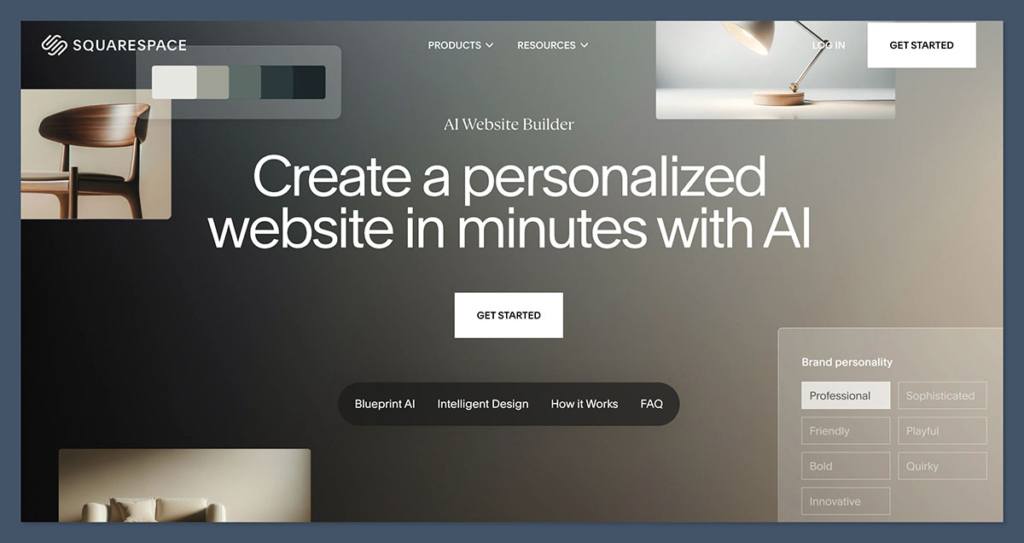
Squarespace has taken a more integrated approach to AI. Their tools aren’t just add-ons — they’re becoming part of the core experience, helping with writing, layout decisions, and even product listings.
AI features available in Squarespace:
- AI content assistant: Generates product descriptions, blog intros, meta descriptions, and more
- Smart layout blocks: Suggests section structures based on content goals
- Image editing tools: AI cropping and background removal (in beta rollout)
- Auto-filled SEO fields: Draft meta titles and descriptions for faster publishing
- AI-integrated email campaigns: Helps write subject lines and email copy
- Style guides + brand voice suggestions: Coming soon as part of their branding toolkit
Real use cases:
- One of my clients used Squarespace’s AI to generate 50 product descriptions in under an hour
- Writers can use AI to generate structured blog outlines for faster publishing
- Visual brands benefit from layout suggestions that reduce guesswork
While it doesn’t replace a proper content strategy, Squarespace’s AI tools are excellent for speeding up production, especially when managing content at scale.
AI Capabilities Comparison Table
| Feature | Format | Squarespace |
|---|---|---|
| AI text generation | Yes (bio, intro copy) | Yes (products, blogs, SEO) |
| Smart layout suggestions | Yes | Yes |
| SEO copy assistance | No | Yes |
| Image editing (AI tools) | No | Yes (beta) |
| Email campaign AI | No | Yes |
| Brand tone/style guidance | No | Yes (rolling out) |
| AI productivity scope | Basic (launch-focused) | Expanding (scaling-focused) |
Final Thoughts:
Format’s AI tools are useful for simple text generation and layout speed — ideal for getting your portfolio online fast. But they don’t go beyond that.
Squarespace is clearly investing in AI as a productivity layer across the entire platform — from writing product descriptions and blog posts to optimising layouts and email campaigns.
If you’re building a content-heavy, ecommerce-driven site — or just want tools that grow with your site — Squarespace’s AI capabilities offer a significant advantage.
Pricing Breakdown
When evaluating website platforms, pricing isn’t just about choosing the cheapest option — it’s about understanding what you’re getting for the money.
Whether you’re a solo artist with a tight budget or a growing ecommerce business, choosing the right tier impacts both your functionality and future scalability.
Format and Squarespace offer transparent pricing, but their plans are structured for different needs.
Format keeps things lean, with creative professionals in mind. Squarespace has more complex tiers, reflecting its broader set of features — especially for ecommerce and marketing.
Format Pricing
Format’s pricing model is streamlined.
All plans include hosting, SSL, and portfolio tools, but higher tiers unlock ecommerce features, more storage, and client tools.
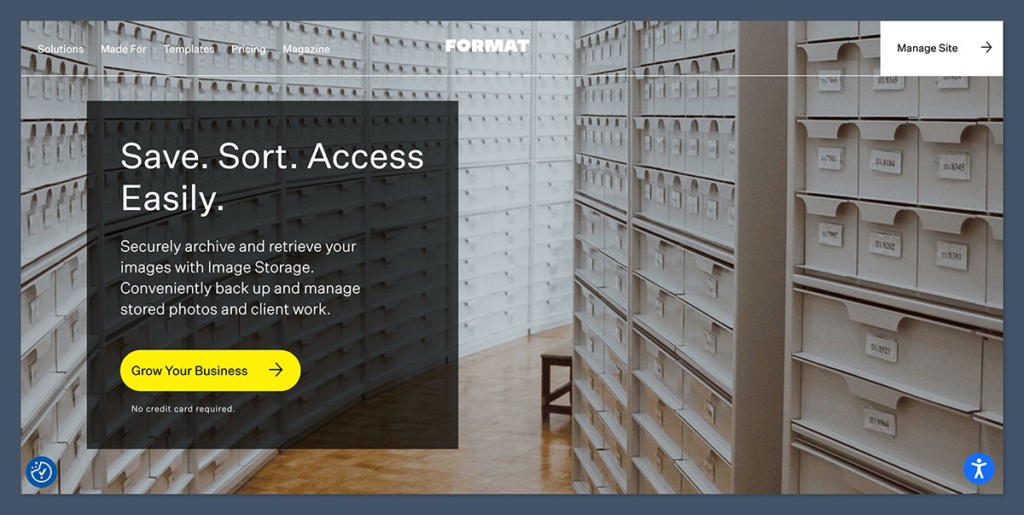
| Plan Name | Price (Monthly, Billed Annually) | Key Features |
|---|---|---|
| Basic | $10/month | 3 pages, basic templates, limited storage |
| Pro | $16/month | 15 pages, basic store, client proofing |
| Pro Plus | $26/month | Unlimited pages, advanced store, watermarking |
| Workflow | $36/month | Client CRM, branded file delivery, full features |
What’s included in all plans:
- Free custom domain for 1 year
- SSL encryption
- Access to all templates
- Built-in client galleries
- Responsive mobile versions
- Customer support
Where the value scales:
- Ecommerce tools (store, digital sales) start at Pro
- Client workflow tools (CRM, branded file delivery) start at Workflow
- Storage limits and image compression are more generous at higher tiers
For most visual creatives, Pro or Pro Plus hits the sweet spot — enough pages to showcase your work and sell products, without unnecessary tools.
Squarespace Pricing
Squarespace is more expansive and offers four core plans, each unlocking additional layers of functionality — from simple sites to full ecommerce operations.
| Plan Name | Price (Monthly, Billed Annually) | Key Features |
|---|---|---|
| Personal | $16/month | Basic site, templates, no ecommerce |
| Business | $23/month | Advanced design tools, basic store (3% fee) |
| Commerce Basic | $27/month | Full store features, 0% fee, analytics, product tools |
| Commerce Advanced | $49/month | Subscriptions, abandoned cart, advanced shipping |
What’s included in all plans:
- SSL certificate
- Free custom domain (1 year)
- 24/7 customer support
- Full access to templates
- Built-in mobile responsiveness
- Basic SEO settings and blogging tools
Where the value increases:
- Serious ecommerce starts at Commerce Basic ($27/month)
- Subscriptions, advanced shipping, and cart recovery require Advanced
- Business is a hybrid plan — good for service providers or mixed-use sites
For sellers or content creators, Commerce Basic is usually the right starting point. It’s where ecommerce features become scalable and fees disappear.
Pricing Comparison Table
| Feature | Format Pro ($16) | Squarespace Business ($23) |
|---|---|---|
| Custom domain | Yes | Yes |
| SSL security | Yes | Yes |
| Number of pages | Up to 15 | Unlimited |
| Client proofing tools | Yes | No (requires integration) |
| Digital product sales | Yes | Yes |
| Physical product sales | Yes (basic) | Yes (basic) |
| Product variants | No | Yes |
| Transaction fees | 0% | 3% (0% on higher tiers) |
| Blogging tools | Limited | Full-featured |
| Subscription products | No | Yes (Advanced plan only) |
Final Thoughts:
Format offers competitive pricing for creatives who want simplicity and purpose-built tools. Its plans scale cleanly, and you’re never paying for features you don’t need.
If your primary focus is showcasing and lightly selling creative work, it’s cost-effective and easy to maintain.
Squarespace costs more as you unlock ecommerce features — but that extra spend comes with real infrastructure: product variations, cart recovery, subscription models, and built-in analytics.
For creators thinking about SEO, blogging, and long-term growth, the investment is justifiable.
If you’re unsure, ask yourself:
- Do I need blogging and content marketing? → Go Squarespace
- Do I just want to sell art and share work with clients? → Start with Format Pro or Pro Plus
Ease of Use
The usability of a platform doesn’t just affect how fast you can build a site — it affects how confident you feel managing it week to week.
I’ve worked with creatives who’ve built amazing portfolios in an afternoon and ecommerce sellers who’ve wasted days trying to figure out clunky dashboards.
When you’re choosing between Format and Squarespace, you’re really choosing between simplicity and flexibility.
Both are polished, modern platforms, but their learning curves are noticeably different depending on your experience level and what you’re trying to do.
Format: Minimal Setup with an Artist-First Interface
Format is designed specifically for creatives — and it shows. From the minute you sign up, you’re guided through a step-by-step process that’s tailored to photographers, designers, illustrators, and visual artists.
What makes Format easy to use:
- Visual-first setup wizard: Choose your industry and site goal, and Format suggests a layout
- Clean, distraction-free dashboard: No unnecessary tabs, no developer tools, no clutter
- Simple page editor: Rearranging galleries or content blocks is intuitive
- Template-locked design: Prevents users from breaking layouts (great for non-tech users)
- Pre-built pages: “About,” “Store,” “Gallery,” “Contact” all come ready to go
- Live preview: See changes instantly without toggling between editor and frontend
Ideal for:
- Beginners who want to publish fast without a deep learning curve
- Visual artists who don’t want to mess with code or SEO settings
- Users who prefer stability over full design freedom
The biggest strength of Format is how unintimidating it is — anyone can launch a clean, professional-looking site within hours.
Squarespace: More Power, More Control — With a Slight Learning Curve
Squarespace gives you far more design and structural flexibility, but with that comes a slightly steeper onboarding process.
The interface is well designed, but there’s more to understand — especially if you’re using ecommerce or blogging tools.
What makes Squarespace more complex (but powerful):
- Block-based editor (Fluid Engine): Drag-and-drop freedom with design controls
- Multiple content types: Pages, products, posts, events, member areas, forms
- Layered settings menus: SEO, social, analytics, marketing — all in separate areas
- Mobile and desktop previews: Switch between screen views as you design
- Custom CSS and JavaScript support: Optional but valuable for advanced users
- Multiple user roles: Let collaborators, writers, or store managers log in securely
Ideal for:
- Users who want full control over layout, branding, and content
- Businesses managing multiple product categories, content strategies, or pages
- Designers or marketers who are used to building out sites with growth in mind
Once you’ve built 1–2 pages and explored the backend, it becomes second nature — but expect to spend a little more time up front.
Ease of Use Comparison Table
| Usability Feature | Format | Squarespace |
|---|---|---|
| Onboarding difficulty | Very low | Moderate |
| Drag-and-drop design | Limited to image blocks | Full Fluid Engine builder |
| Dashboard layout | Minimal and clean | Feature-rich, more layered |
| Template editing | Fixed layout templates | Highly customisable |
| Page creation speed | Very fast | Moderate (more options to set up) |
| Ecommerce setup | Streamlined (simple store) | Deep setup with options |
| Blogging/editor workflow | Basic text editor | Full content builder |
| SEO and metadata access | Minimal | Full access |
| Custom code or developer access | Not available | Available (CSS, JS, custom blocks) |
| Mobile editing | Yes (simple changes) | Yes (more powerful tools) |
Final Thoughts:
Format is the easiest platform for creatives who just want to get online quickly, display their work beautifully, and make light edits over time.
It’s ideal for solo artists, freelancers, or photographers who don’t want to think about “web stuff.”
Squarespace offers more creative freedom and deeper control — but it takes more upfront learning.
For users who plan to run an ecommerce store, publish consistently, or scale their brand, the investment in learning pays off quickly.
If you’re looking for speed and simplicity, Format delivers.
If you’re planning to build a site that grows with your business, Squarespace offers the flexibility and tools to make that happen.
Customer Support and Reviews
Customer support can make or break the user experience — especially if you’re managing your site solo or under tight deadlines.
I’ve worked with dozens of clients who hit a wall mid-project and needed fast, competent help. In those moments, support isn’t a bonus — it’s critical.
Both Format and Squarespace offer strong documentation and live help, but they differ in response times, support channels, and customer satisfaction across platforms like Trustpilot, Reddit, and Capterra.
Let’s look at how each performs when things go wrong — or when you just need a nudge in the right direction.
Format: Focused Support for Creatives
Format offers a tight, highly relevant support experience aimed at its core user base — artists, photographers, and designers.
The documentation is clear, the responses are fast, and the support agents typically understand the creative use cases without needing long explanations.
Format support channels:
- Live chat (weekdays, standard business hours)
- Email support (responses within 24 hours)
- Priority email support on higher-tier plans
- Help Centre with searchable articles and walkthroughs
- Video tutorials geared toward visual learners
- In-app tips and contextual help when editing
Pros:
- Support agents understand creative workflows (e.g. proofing, galleries, client previews)
- Fast response time on Pro and Workflow plans
- Clear guidance for beginners
Cons:
- No 24/7 live chat
- No phone support
- Limited support for advanced SEO, integrations, or ecommerce issues
For most creatives with straightforward needs, Format support does the job well — especially if you’re on a paid plan.
Squarespace: Scalable Support for a Broad User Base
Squarespace supports a much wider range of users — from bloggers and podcasters to ecommerce stores and agencies. As a result, their support system is more robust and multi-tiered, though sometimes less personal.
Squarespace support channels:
- Live chat (24/7 availability)
- Email support (typically responds in under 1 business day)
- Community forum with thousands of answered questions
- Help Centre with deep documentation and walkthroughs
- Video workshops and webinars
- Developer documentation for advanced users
Pros:
- 24/7 availability, including weekends and holidays
- Extensive knowledge base for almost every feature
- Active community where real users share solutions
- Better support for ecommerce and SEO questions
Cons:
- Can feel impersonal due to scale
- Limited guidance on creative-specific features (e.g. galleries or artist workflows)
- Phone support not available
If you’re managing a more complex site — especially one with content layers or ecommerce — Squarespace support gives you more technical depth and availability.
Support Comparison Table
| Support Feature | Format | Squarespace |
|---|---|---|
| Live chat availability | Weekdays only | 24/7 live chat |
| Email support response time | Within 24 hours | Within 1 business day |
| Phone support | No | No |
| Priority support | On Pro Plus & Workflow plans | Not tiered, but generally fast |
| Support knowledge base | Yes (simple and clear) | Yes (extensive and detailed) |
| Video tutorials/workshops | Yes | Yes |
| Developer-level documentation | No | Yes |
| Community forums | No | Yes |
| Support agents familiar with artists | Yes | Sometimes |
Real Customer Reviews
Format (from Capterra & Trustpilot):
- ★ 4.5/5 average rating
- Praise for simplicity, visual design, and support that “feels human”
- Criticism mainly focused on limited feature depth, not support quality
Squarespace (from Trustpilot, Reddit, and G2):
- ★ 4.1/5 average rating
- Strong ratings for uptime, design flexibility, and ecommerce tools
- Some complaints about slow chat queues during high-traffic times or holidays
- Mixed experiences with agents depending on the complexity of the issue
Final Thoughts:
Format offers direct, intuitive support built for creatives who want clarity and speed. It shines when you’re dealing with portfolio issues, client galleries, or visual presentation concerns.
Squarespace delivers scalable support that handles everything from SEO configurations to ecommerce logistics — but occasionally at the cost of personalisation.
If you want fast, focused answers about creative-specific features, Format wins.
If you need broader support for technical site management, SEO, or product setup, Squarespace is better equipped to handle it.
Let me know if you’d like me to include quotes from actual users or Reddit threads for a more grounded perspective.
Final Verdict: Format vs Squarespace
After more than a decade working with creative entrepreneurs, online stores, and artists, I’ve learned that choosing a website platform isn’t just about features — it’s about fit.
Format and Squarespace both do excellent work — but they’re designed with very different intentions.
If you’re an artist, photographer, or creative professional looking to showcase your portfolio quickly, with minimal setup and no distractions, Format is a purpose-built solution.
It respects your time, keeps things simple, and makes it easy to deliver your work to clients and sell occasional pieces without worrying about complexity.
If you’re building a brand that’s meant to grow with content, sell consistently online, and compete in search, Squarespace is the more scalable, flexible, and SEO-friendly option.
It’s not as streamlined out of the box, but the extra tools give you far more control — especially once you start to grow.
Who Should Choose Format?
- Visual creatives who want a minimalist, polished portfolio site
- Artists who only need light ecommerce functionality (prints, services, downloads)
- Photographers who rely on client proofing and private gallery access
- Users with no interest in blogging, SEO, or managing a growing content ecosystem
You should not choose Format if you:
- Plan to grow traffic through content marketing or SEO
- Need product variants, subscriptions, or advanced ecommerce tools
- Want full control over your site structure, layout, or URLs
- Expect to scale into a broader content or sales platform
Who Should Choose Squarespace?
- Creators and entrepreneurs who publish regularly or build around SEO
- Ecommerce sellers who need product variations, subscriptions, or scalable tools
- Visual brands that want design flexibility without hiring developers
- Content creators who want to integrate blogs, video, newsletters, and ecommerce
You should not choose Squarespace if you:
- Want to launch something immediately with no learning curve
- Need only a simple portfolio and don’t plan to add content or commerce
- Are overwhelmed by dashboard complexity or site structure menus
Feature Comparison: Format vs Squarespace
| Feature Category | Format | Squarespace |
|---|---|---|
| Best for | Visual portfolios | Content + ecommerce-driven sites |
| Ease of use | Extremely easy | Moderate learning curve |
| Blogging tools | Basic | Full CMS functionality |
| SEO features | Minimal | Comprehensive |
| Ecommerce | Light/simple | Advanced + scalable |
| Templates | Creative-first | Broad + fully customisable |
| Hosting + security | Reliable and lightweight | Enterprise-grade infrastructure |
| AI tools | Basic for setup | Expanding across features |
| Pricing | Lower overall cost | Higher, but more functionality |
| Customer support | Creative-focused | Broader and 24/7 |
My Recommendation (Based on 10+ Years in the Field):
If you’re a creative who doesn’t want to think about content strategy or product catalogs, go with Format. It’s beautifully designed for what it’s meant to do — and that’s a rare thing.
If you’re building something that needs to rank in search, sell across multiple channels, or grow through content, start with Squarespace. It gives you all the tools you’ll eventually need, even if you’re not using them on day one.
No one platform is “better” — it comes down to how serious you are about building a brand, not just a website.
Also Consider These Alternatives
If you’re still unsure, these platforms may offer a better fit depending on your priorities:
| Platform | Best For |
|---|---|
| Shopify | Pure ecommerce with heavy inventory or scaling needs |
| Wix | Beginners who want drag-and-drop freedom with more templates |
| Webflow | Designers and developers who want full control and custom animations |
| WordPress | Content-heavy or SEO-first websites with plugin flexibility |
| Pixpa | Portfolio websites with stronger ecommerce than Format, but less content control than Squarespace |






